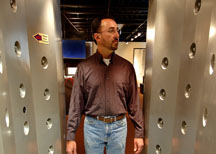TSA installs Sandia licensee’s explosives-sniffing walk-through portal at airport terminal

Airline passengers at a security checkpoint at New York’s John F. Kennedy International Airport are being screened for faint traces of explosives using a walk-through sniffing portal that incorporates explosives-detection technology originally developed at Sandia.
The Transportation Security Administration (TSA) announced Oct. 25 that it had purchased five Ionscan Sentinel Contraband Detection Portals from Smiths Detection and placed one of the portals at JFK’s Terminal One.
The portal will remain at JFK for at least 90 days during a TSA pilot program to evaluate emerging explosives detection technology. Other airports may follow
It is the first time the Sandia-pioneered technology has been used for actual airline passenger security screenings. (A prototype portal was tested temporarily at the Albuquerque International Sunport in 1997 to screen 2,400 volunteers.)
“Evaluations of these systems in real-world environments is critical to the successful deployment of new technologies in security applications,” says Rebecca Horton, Manager of Entry Control and Contraband Detection Dept. 4118.
Pause for screening
The portals, which look like walk-through metal detectors, screen people for minute traces of explosives at checkpoints. As part of the screening process, airline passengers are asked to step inside one of the portals and stand still for several seconds while their carry-on bags are being X-rayed separately.
As each passenger pauses inside the portal, a puff of air dislodges particles and vapors from their clothing and skin. An air sample is collected and analyzed. If traces of an explosive chemical are found, an alarm sounds and the passenger is questioned.
Smiths Detection says each portal is capable of screening 420 passengers per hour and can reliably detect traces of contamination on a person who has handled explosives. It also snaps a digital photograph of each passenger and keeps it temporarily
The TSA had been conducting an evaluation of several portal technologies, including the Sentinel, at the FAA Tech Center in New Jersey (now called the Transportation Security Laboratory). Meanwhile, several of the Smiths Detection portals have been in operation in non-airport settings, such as at the CN Tower in Toronto to screen visitors.
Similar trace-detection portals made by GE, one of Smiths Detection’s competitors, also were placed at five US airports and one rail station in June as part of the TSA’s test and evaluation pilot program.
Pause inside portal
Barringer Instruments, which later was acquired by Smiths Detection, licensed both the Sandia-patented air-flow design and air sampling techniques from Sandia in 1999 and incorporated the technologies into the Ionscan Sentinel.
Potential users for the walk-through portals include the armed forces and security screeners at airports, military bases, embassies, public buildings, prisons, courtrooms, sporting venues, and schools.
TSA officials say the tests could help determine whether explosives-detection portals will be installed at all US airports.
“As a Sandian, it is very rewarding to be part of a technology that evolved from a laboratory research idea to a commercial product for national security that could save lives,” says Kevin Linker (4118), one of the Sandia developers.